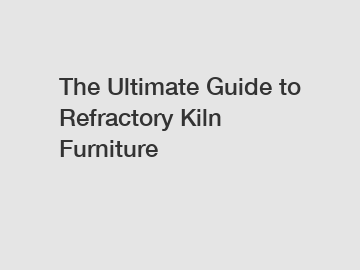The Ultimate Guide to Refractory Kiln Furniture
The Ultimate Guide to Refractory Kiln Furniture.
Refractory kiln furniture plays an integral role in the firing process of various industries like ceramics, glass, and metals. It provides support and protection to delicate products within high-temperature environments. If you are new to the realm of refractory kiln furniture or in need of a refresher, this ultimate guide will walk you through everything you need to know.
Understanding Refractory Kiln Furniture:

Refractory kiln furniture refers to the various components used in kilns to hold and support products during the firing process. These components are made from refractory materials such as fireclay, kaolin, or silica, which have the ability to withstand extreme heat without warping or deforming. The key characteristics of refractory kiln furniture include high thermal shock resistance, excellent dimensional stability, and low thermal expansion.
Types of Refractory Kiln Furniture:
1. Shelves and Batt Systems:
- Shelves: Shelves are flat platforms that hold and support ceramic or glassware during firing. They are typically made from cordierite, a high-temperature ceramic material known for its strength and stability.
- Batt Systems: Batt systems consist of multiple shelves stacked together, providing a more efficient use of kiln space.
2. Props and Setters:
- Props: Props are vertical support pillars that help create layers within the kiln. They can be adjusted to accommodate different product sizes and create optimal airflow and heat distribution.
- Setters: Setters are horizontal platforms placed between layers of shelves. They provide additional support and help separate products during firing to ensure consistent heat circulation.
3. Tubes and Beams:
- Tubes: Tubes are cylindrical structures used for firing elongated ceramic or glass products. They allow for even heating and help prevent deformation during the firing process.
- Beams: Beams are horizontal support structures that span across the kiln. They provide stability and ensure uniform heat distribution.
Choosing the Right Refractory Kiln Furniture:
When selecting refractory kiln furniture, several factors should be considered:
- Temperature range: Ensure the furniture can withstand the operating temperatures of your kiln.
- Thermal shock resistance: Look for materials with high thermal shock resistance to prevent cracking or damage during rapid temperature changes.
- Chemical compatibility: Consider the materials being fired and choose furniture that is chemically compatible to avoid reactions or contamination.
- Load-bearing capacity: Determine the weight and size of the products you will be firing and select furniture capable of supporting them.
Maintenance and Safety:
Proper maintenance of refractory kiln furniture is essential to ensure its longevity and optimal performance. Regularly inspect for cracks, warping, or signs of wear and replace any damaged pieces. Additionally, follow all safety protocols when operating kilns to prevent accidents or injuries.
Contact Us:
If you have any further questions or need assistance with refractory kiln furniture, our team of experts is here to help. Please contact us for additional information or to discuss your specific requirements.
In conclusion, refractory kiln furniture is vital for the successful firing of ceramics, glass, and metal products. Understanding the different types, choosing the right materials, and practicing proper maintenance are crucial for achieving optimal results. By following this ultimate guide, you can be well-equipped to ensure the efficiency and reliability of your kiln operations. Contact us today to explore our range of refractory kiln furniture and find the perfect solution for your needs.
For more industrial furnaces refractory bricks, refractory mortar, high alumina bricksinformation, please contact us. We will provide professional answers.
162
0
0

Comments
All Comments (0)